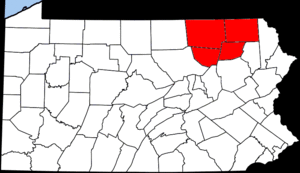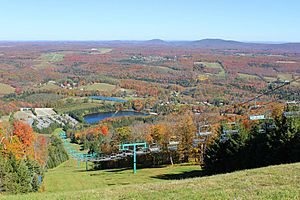Endless Mountains facts for kids
The Endless Mountains are a special area in Northeastern Pennsylvania, United States. This region includes four counties: Bradford, Sullivan, Susquehanna, and Wyoming. The highest point here is the North Knob of Elk Mountain, which stands at 2,693 feet (821 meters) tall.
What are the Endless Mountains Like?

Even though they are called "mountains," this area is actually a dissected plateau. Think of it like a high, flat area that has been cut into many hills and valleys by rivers over a very long time. It's part of the larger Appalachian Mountains chain. To the east, the Catskill Mountains are also part of this same plateau, separated by the Delaware River.
About 15,000 years ago, a huge sheet of ice called the Wisconsin Glacier covered parts of this area. The glacier changed the land a little. You can still find marks on some rocks from where the ice scraped them. However, this area was at the edge of the ice sheet, so it wasn't changed as much as places further north in New York.
The "mountains" are made of sedimentary rock. This means they formed from layers of sand and mud that settled over millions of years. Most of the rocks are sandstone and shale. Over time, the land has been lifted up and lowered many times. The highest points are all about the same height. This shows that the area was once a very flat plain before it was lifted up.
The Susquehanna River flows through this region. It has a winding path with many bends. When the land was lifted, these bends were kept, creating deep, curving valleys. The river cut a deep path, and its smaller streams then carved the plateau into the rugged hills we see today.
A Look at the History of the Endless Mountains

Long ago, different Native American groups lived in the Endless Mountains. When European settlers arrived, the main groups were the Munsee-Lenape, Susquehannock, and Iroquois peoples. Many of the local place names come from the Munsee-Lenape language. For example, "Lock-ah Hanna" means Sand River, and "Tunk Hanna Unk" means Bend River Place.
In 1768, a treaty was signed between the Iroquois League and the British. This agreement meant that many Native American groups, including the Munsee, had to leave the area. After this, many families from England, Ireland, and Germany moved in. They came from New England, New York, New Jersey, and other parts of Pennsylvania.
These new settlers bought land from different companies. However, the Penn family, who owned Pennsylvania, also claimed this land. This led to fights over who owned the land, known as the Pennamite Wars.
During the American Revolution in 1778, a group of British soldiers, loyalists, and Native Americans attacked settlers in the Wyoming Valley. Many settlers were killed. To stop future attacks, General John Sullivan led a campaign. His troops traveled up the Susquehanna and Chemung Rivers, destroying villages and crops in central and western New York.
In the past, the economy of the Endless Mountains was mostly about mining, cutting down trees (called lumbering), and other industries. A lot of hemlock trees were cut down for their bark, which was used to make leather. Today, the area is mostly agricultural. This means many people work on farms. Forestry (managing forests) and tourism (people visiting for fun) also help the economy.
Even though much of the land is steep, there are good farms on rolling hilltops and in valleys. Many Mennonite and Amish families have moved here. They came from areas where their traditional farmlands were being developed into towns and cities.
Quarrying is still an important industry here. This is where people dig out valuable rocks. The region is known for its high-quality "blue stone." This area is also near Pennsylvania's Coal Region, and some small amounts of coal can be found here.
A famous songwriter named Stephen Foster once lived in this area. The town of Camptown in Bradford County is even mentioned in his famous song, Camptown Races.



